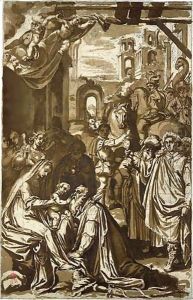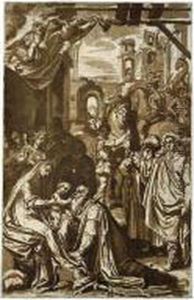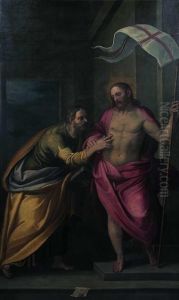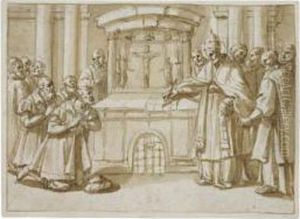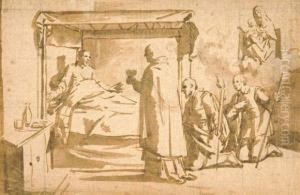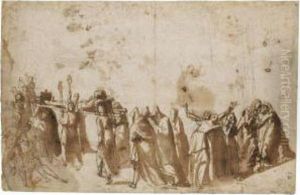Giovanni Battista Ricci Da Novara Paintings
Giovanni Battista Ricci, known also as Giovanni Battista Ricci Da Novara, was an Italian painter of the late Renaissance and early Baroque periods, born in Novara, Duchy of Milan, in 1537. His work is characterized by its religious themes, intricate detail, and the use of light, which reflects the transition from the Renaissance to the Baroque era in Italian art. Ricci's career is a testament to the stylistic shifts in Italian painting during his lifetime and his ability to adapt and thrive within them.
Ricci's early life is somewhat obscure, but it is known that he moved to Rome at a young age to pursue his artistic training. In Rome, he became a part of the vibrant artistic community, absorbing the influences of the Renaissance masters and the emerging Baroque style. His work was greatly influenced by the Mannerist style, which is evident in his early paintings that feature elongated figures and an artificial approach to representation.
Throughout his career, Ricci worked on various important commissions, including frescoes and altarpieces for churches and chapels in Rome and its surrounding areas. His ability to blend the grandeur of the Renaissance with the dynamism of the Baroque made him a favorite among patrons. One of his most significant contributions was his work in the Basilica di Santa Maria Maggiore in Rome, where his frescoes are among the highlights.
Ricci's influence extended beyond his immediate circle through his students and followers. Despite the lack of extensive documentation on his teaching, it's known that he played a significant role in the development of several artists who would carry forward the traditions of the Baroque period. Ricci's legacy is not only in his contributions to the major Roman basilicas and churches but also in his ability to encapsulate the spiritual and emotional depth of the Counter-Reformation period through his art.
Giovanni Battista Ricci Da Novara died in 1627, leaving behind a body of work that continues to be studied and admired for its artistic significance and historical importance. His paintings are a window into the transitional period of Italian art, bridging the gap between the High Renaissance and the full flourish of the Baroque. Ricci's work remains a testament to the enduring power of religious art to convey spiritual truths through beauty and innovation.
